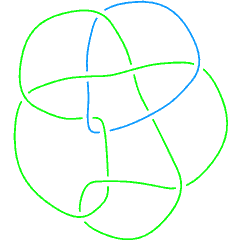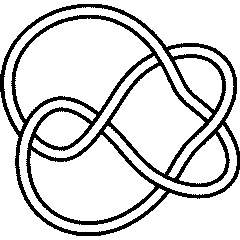Identifying Knots within a List: Difference between revisions
(New page: {{Manual TOC Sidebar}} ==IdentifyWithin== IdentifyWithin[L,H] returns those elements from the list of knots H, whose invariant matches that of the knot L. It can also recognize mirrors a...) |
No edit summary |
||
| (8 intermediate revisions by one other user not shown) | |||
| Line 1: | Line 1: | ||
{{Manual TOC Sidebar}} |
{{Manual TOC Sidebar}} |
||
<code>IdentifyWithin[L,H]</code>, whose code is available [[IdentifyWithin.m|here]], returns those elements from the list of knots <math>H</math>, whose invariant matches that of the knot <math>L</math>. It can also recognize mirrors and connected sums of the knots in the list. Its options include turning off (on) the search for connected sums with <code>ConnectedSum->False (True)</code> and choosing the invariants to be used in identification by selecting, for example, <code>Invariants->{Jones[#][q]&, HOMFLYPT[#][a,z]&}</code>. |
|||
==IdentifyWithin== |
|||
<code>IdentifyWithin</code> can be used together with [[Prime Links with a Non-Prime Component|<code>SubLink</code>]] to determine the components of a link. For the second component of link [[L11n150]], for instance, we get: |
|||
IdentifyWithin[L,H] returns those elements from the list of knots H, whose invariant matches that of the knot L. It can also recognize mirrors and connected sums of the knots in the list. Its options include turning off (on) the search for connected sums with ConnectedSum->False (True) and choosing the invariants to be used in identification by selecting, for example, Invariants->{Jones[#][q]&, HOMFLYPT[#][a,z]&}. |
|||
IdentifyWithin can be used together with [[Prime Links with a Non-Prime Component|SubLink]] to determine the components of a link. For the second component of link [[L11n150]], for instance, we get: |
|||
{{Startup Note}} |
{{Startup Note}} |
||
<!--$$Import["http://katlas.org/w/index.php?title=IdentifyWithin.m&action=raw"];$$--> |
|||
<!--Robot Land, no human edits to "END"--> |
|||
{{In| |
|||
n = 2 | |
|||
in = <nowiki>Import["http://katlas.org/w/index.php?title=IdentifyWithin.m&action=raw"];</nowiki>}} |
|||
<!--END--> |
|||
<!--$$Import["http://katlas.org/w/index.php?title=SubLink.m&action=raw"];$$--> |
|||
<!--Robot Land, no human edits to "END"--> |
|||
{{In| |
|||
n = 3 | |
|||
in = <nowiki>Import["http://katlas.org/w/index.php?title=SubLink.m&action=raw"];</nowiki>}} |
|||
<!--END--> |
|||
<!--$$IdentifyWithin[SubLink[Link["L11n150"], 2], AllKnots[]]$$--> |
<!--$$IdentifyWithin[SubLink[Link["L11n150"], 2], AllKnots[]]$$--> |
||
<!--Robot Land, no human edits to "END"--> |
<!--Robot Land, no human edits to "END"--> |
||
{{InOut| |
{{InOut| |
||
n = |
n = 4 | |
||
in = <nowiki>IdentifyWithin[SubLink[Link["L11n150"], 2], AllKnots[]]</nowiki> | |
in = <nowiki>IdentifyWithin[SubLink[Link["L11n150"], 2], AllKnots[]]</nowiki> | |
||
out= <nowiki>{Knot[5, 2]}</nowiki>}} |
out= <nowiki>{Knot[5, 2]}</nowiki>}} |
||
<!--END--> |
<!--END--> |
||
{{Knot Image Pair|L11n150|gif|5_2|gif}} |
{{Knot Image Pair|L11n150|gif|5_2|gif}} |
||
Unfortunately, the program does not provide absolute identification when all the used invariants cannot distinguish between two or more different knots. In that case, a list of possible candidates for <math>L</math> is returned. |
|||
Unfortunately, the program does not provide absolute identification when all the used invariants cannot distinguish between two or more different knots. In that case, a list of possible candidates for L is returned. |
|||
<!--$$Options[IdentifyWithin] = { |
|||
Invariants -> {Jones[#][q] &, HOMFLYPT[#][a, z] &, |
|||
Kauffman[#][a, z] &}, |
|||
ConnectedSum -> "True"}; |
|||
IdentifyWithin[L_, H_List, opts___Rule] := |
|||
Module[ |
|||
{div, j = 1, l, i = 1, u, mu, t, mt, out = {}, out1 = {}, nk, mnk, |
|||
mnk1, p, mp, m, p1, |
|||
invariants = (Invariants /. {opts} /. Options[IdentifyWithin]), |
|||
connectedsum = (ConnectedSum /. {opts} /. |
|||
Options[IdentifyWithin])}, |
|||
NormalizeP[poly_] := Module[{t1, i1}, |
|||
(For[i1 = 1 ; t1 := FactorList[poly], |
|||
i1 <= Length[Variables[poly]], i1++, |
|||
t1 = |
|||
DeleteCases[t1, {Variables[poly][[i1]], _Integer} | {1, 1}]]; |
|||
Times @@ Power @@@ t1 )]; |
|||
l := Length[invariants]; |
|||
u[0] = mu[0] = H; |
|||
While[i <= l && ! Length[out] === 1, |
|||
t[i] = invariants[[i]][L]; |
|||
mt[i] = invariants[[i]][Mirror[L]]; |
|||
u[i] = Select[u[i - 1], t[i] == invariants[[i]][#] &]; |
|||
mu[i] = Select[mu[i - 1], mt[i] == invariants[[i]][#] &]; |
|||
out = Flatten[{u[i], Mirror /@ mu[i]}]; |
|||
i++]; |
|||
Which[ |
|||
Length[out] >= 2, DeleteCases[out, Mirror[Knot[0, 1]]], |
|||
Length[out] == 1, |
|||
out = If[u[i - 1] != {}, u[i - 1], Mirror /@ mu[i - 1]], |
|||
connectedsum === "True", i = 1; nk[0] = mnk[0] = H; |
|||
While[Length[out1] != 1 && i <= l, |
|||
p[i] = NormalizeP[t[i]]; |
|||
mp[i] = NormalizeP[mt[i]]; |
|||
nk[i] = |
|||
Select[nk[i - 1], (p1 = NormalizeP[invariants[[i]][#]]; z = 3; |
|||
PolynomialRemainder[p[i], p1, Variables[p[i]][[1]]] === |
|||
0 ) &]; |
|||
mnk[i] = |
|||
Select[mnk[i - 1], (p1 = NormalizeP[invariants[[i]][#]]; z = 3; |
|||
PolynomialRemainder[mp[i], p1, Variables[p[i]][[1]]] === |
|||
0 ) &]; |
|||
Clear[z]; |
|||
mnk1[i] = Mirror /@ mnk[i]; |
|||
div = Flatten[{nk[i], mnk1[i]}]; |
|||
div = DeleteCases[div, Knot[0, 1] | Mirror[Knot[0, 1]]]; |
|||
If[div == {}, out1 = {}, |
|||
For[m = 1; |
|||
W[0] = |
|||
CS[0] = Select[ |
|||
Flatten /@ Flatten[Outer[List, div, div, 1], 1], OrderedQ], |
|||
Length[W[m - 1][[1]]] < 4, m++, |
|||
W[m] = Select[ |
|||
Flatten /@ Flatten[Outer[List, div, W[m - 1], 1], 1], |
|||
OrderedQ]; |
|||
CS[m] = Flatten[{CS[m - 1], W[m]}, 1]; |
|||
]; |
|||
out1 = |
|||
Select[CS[m - 1], |
|||
Expand[Times @@ invariants[[i]] /@ #] == t[i] &]; |
|||
]; |
|||
i++]; |
|||
If[out1 == {}, {}, ConnectedSum @@@ out1], True, {} |
|||
] |
|||
];$$--> |
|||
<!--Robot Land, no human edits to "END"--> |
|||
{{In| |
|||
n = 3 | |
|||
in = <nowiki>Options[IdentifyWithin] = { |
|||
Invariants -> {Jones[#][q] &, HOMFLYPT[#][a, z] &, |
|||
Kauffman[#][a, z] &}, |
|||
ConnectedSum -> "True"}; |
|||
IdentifyWithin[L_, H_List, opts___Rule] := |
|||
Module[ |
|||
{div, j = 1, l, i = 1, u, mu, t, mt, out = {}, out1 = {}, nk, mnk, |
|||
mnk1, p, mp, m, p1, |
|||
invariants = (Invariants /. {opts} /. Options[IdentifyWithin]), |
|||
connectedsum = (ConnectedSum /. {opts} /. |
|||
Options[IdentifyWithin])}, |
|||
NormalizeP[poly_] := Module[{t1, i1}, |
|||
(For[i1 = 1 ; t1 := FactorList[poly], |
|||
i1 <= Length[Variables[poly]], i1++, |
|||
t1 = |
|||
DeleteCases[t1, {Variables[poly][[i1]], _Integer} | {1, 1}]]; |
|||
Times @@ Power @@@ t1 )]; |
|||
l := Length[invariants]; |
|||
u[0] = mu[0] = H; |
|||
While[i <= l && ! Length[out] === 1, |
|||
t[i] = invariants[[i]][L]; |
|||
mt[i] = invariants[[i]][Mirror[L]]; |
|||
u[i] = Select[u[i - 1], t[i] == invariants[[i]][#] &]; |
|||
mu[i] = Select[mu[i - 1], mt[i] == invariants[[i]][#] &]; |
|||
out = Flatten[{u[i], Mirror /@ mu[i]}]; |
|||
i++]; |
|||
Which[ |
|||
Length[out] >= 2, DeleteCases[out, Mirror[Knot[0, 1]]], |
|||
Length[out] == 1, |
|||
out = If[u[i - 1] != {}, u[i - 1], Mirror /@ mu[i - 1]], |
|||
connectedsum === "True", i = 1; nk[0] = mnk[0] = H; |
|||
While[Length[out1] != 1 && i <= l, |
|||
p[i] = NormalizeP[t[i]]; |
|||
mp[i] = NormalizeP[mt[i]]; |
|||
nk[i] = |
|||
Select[nk[i - 1], (p1 = NormalizeP[invariants[[i]][#]]; z = 3; |
|||
PolynomialRemainder[p[i], p1, Variables[p[i]][[1]]] === |
|||
0 ) &]; |
|||
mnk[i] = |
|||
Select[mnk[i - 1], (p1 = NormalizeP[invariants[[i]][#]]; z = 3; |
|||
PolynomialRemainder[mp[i], p1, Variables[p[i]][[1]]] === |
|||
0 ) &]; |
|||
Clear[z]; |
|||
mnk1[i] = Mirror /@ mnk[i]; |
|||
div = Flatten[{nk[i], mnk1[i]}]; |
|||
div = DeleteCases[div, Knot[0, 1] | Mirror[Knot[0, 1]]]; |
|||
If[div == {}, out1 = {}, |
|||
For[m = 1; |
|||
W[0] = |
|||
CS[0] = Select[ |
|||
Flatten /@ Flatten[Outer[List, div, div, 1], 1], OrderedQ], |
|||
Length[W[m - 1][[1]]] < 4, m++, |
|||
W[m] = Select[ |
|||
Flatten /@ Flatten[Outer[List, div, W[m - 1], 1], 1], |
|||
OrderedQ]; |
|||
CS[m] = Flatten[{CS[m - 1], W[m]}, 1]; |
|||
]; |
|||
out1 = |
|||
Select[CS[m - 1], |
|||
Expand[Times @@ invariants[[i]] /@ #] == t[i] &]; |
|||
]; |
|||
i++]; |
|||
If[out1 == {}, {}, ConnectedSum @@@ out1], True, {} |
|||
] |
|||
];</nowiki>}} |
|||
<!--END--> |
|||
Latest revision as of 15:04, 20 October 2013
IdentifyWithin[L,H], whose code is available here, returns those elements from the list of knots , whose invariant matches that of the knot . It can also recognize mirrors and connected sums of the knots in the list. Its options include turning off (on) the search for connected sums with ConnectedSum->False (True) and choosing the invariants to be used in identification by selecting, for example, Invariants->{Jones[#][q]&, HOMFLYPT[#][a,z]&}.
IdentifyWithin can be used together with SubLink to determine the components of a link. For the second component of link L11n150, for instance, we get:
(For In[1] see Setup)
In[2]:=
|
Import["http://katlas.org/w/index.php?title=IdentifyWithin.m&action=raw"];
|
In[3]:=
|
Import["http://katlas.org/w/index.php?title=SubLink.m&action=raw"];
|
In[4]:=
|
IdentifyWithin[SubLink[Link["L11n150"], 2], AllKnots[]]
|
Out[4]=
|
{Knot[5, 2]}
|
 L11n150 |
 5_2 |
Unfortunately, the program does not provide absolute identification when all the used invariants cannot distinguish between two or more different knots. In that case, a list of possible candidates for is returned.

